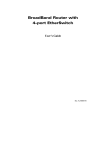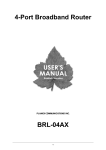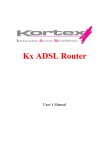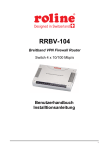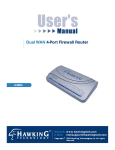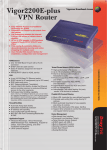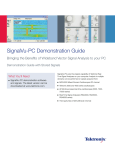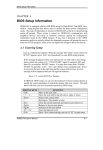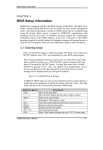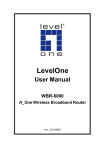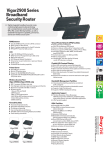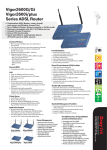Download Hawking Technology H-BR49 User's Manual
Transcript
H-BR49 4-Port Broadband Router Trademarks & Copyright Windows 95/98/ME and Windows NT/2000/XP are registered trademarks of Microsoft Corp. All other brands and product names are trademarks of their respective companies. No part of this publication may be reproduced in any form or by any means or used to make any derivative (such as translation, transformation or adaptation) without the express written consent of the manufacturer as stipulated by the United States Copyright Act of 1976. FCC Certifications This equipment has been tested and found to comply with the limits for a Class B digital device, pursuant to Part 15 of the FCC Rules. These limits are designed to provide reasonable protection against harmful interference in a residential installation. This equipment generates, uses and can radiate radio frequency energy and, if not installed and used in accordance with the instructions, may cause harmful interference to radio communications. However, there is no guarantee that interference will not occur in a particular installation. If this equipment does cause harmful interference to radio or television reception, which can be determined by turning the equipment off and on, the user is encouraged to try to correct the interference by one or more of the following measures: • Reorient or relocate the receiving antenna. • Increase the separation between the equipment and receiver. • Connect the equipment into an outlet on a circuit different from that to which the receiver is connected. • Consult the dealer or an experienced radio/TV technician for help. Shielded interface cables must be used in order to comply with emission limits. You are cautioned that changes or modifications not expressly approved by the party responsible for compliance could void your authority to operate the equipment. This device complies with Part 15 of the FCC rules. Operation is subject to the following two conditions: (1) This device may not cause harmful interference, and (2) This device must accept any interference received, including interference that may cause undesired operation. CE Mark Warning This is a Class B product. In a domestic environment, this product may cause radio interference, in which case the user may be required to take adequate measures. All trademarks and brand names are the property of their respective proprietors. Specifications are subject to change without prior notification. HAWKING LIMITED WARRANTY Hawking Technology guarantees that every H-BR49 Broadband Router is free from physical defects in material and workmanship under normal use for two (2) years from the date of purchase. If the product proves defective during this two-year warranty period, call Hawking Customer Service in order to obtain a Return Authorization number. Warranty is for repair or replacement only. Hawking Technology does not issue any refunds. BE SURE TO HAVE YOUR PROOF OF PURCHASE. RETURN REQUESTS CAN NOT BE PROCESSED WITHOUT PROOF OF PURCHASE. When returning a product, mark the Return Authorization number clearly on the outside of the package and include your original proof of purchase. IN NO EVENT SHALL HAWKING TECHNOLOGY’S LIABILTY EXCEED THE PRICE PAID FOR THE PRODUCT FROM DIRECT, INDIRECT, SPECIAL, INCIDENTAL OR CONSEQUENTIAL DAMAGES RESULTING FROM THE USE OF THE PRODUCT, ITS ACCOMPANYING SOFTWARE OR ITS DOCUMENTATION. Hawking Technology makes no warranty or representation, expressed, implied or statutory, with respect to its products or the contents or use of this documentation and all accompanying software, and specifically disclaims its quality, performance, merchantability, or fitness for any particular purpose. Hawking Technology reserves the right to revise or update its products, software, or documentation without obligation to notify any individual or entity. Please direct all inquiries to: [email protected]. Introduction……………………………………………………………………………5 Factory Default Settings…………………………………………………………….10 Configuration via the Web……………………………………………………….....13 Changing Passwords…………………………………………………………………42 Configuration via GUI……………………………………………………………….43 FAQ…………………………………….…………………………………………….57 Appendix……………………………………………………………………………. 65 The H-BR49 Broadband Router is an integrated Internet IP sharing device with a built-in 4-port 10/100Mbps N-Way Fast Ethernet switch. It has superb throughput of up to 35Mbps between Internet and LAN, making it the perfect solution to connect a small group of PCs to a high-speed broadband Internet connection. Multiple users can have high-speed Internet access simultaneously via one single IP address (Internet account) of the Cable/xDSL modem. This product also serves as an Internet firewall, and thus protects your network from being accessed by outside users. All incoming data packets are monitored and filtered. The Router can also be configured to filter internal user access to the Internet. The built-in 4-port Fast Ethernet Switch lets users plug the network cable into the device without buying an additional Hub/Switch. In addition, the unit is equipped with an Incoming Mail Indicator, which will become lit when there is e-mail waiting to be retrieved at the mail server. Figure 1: Sample Application Features • • • • • • • • • • • • • • • • • • • • Superb performance with throughput of up to 35Mbps between Internet and LAN. Web and GUI management. Supports PPPoE. Supports VPN. (PPTP, IP- Sec pass thru) Supports Auto MDI/MDIX for the LAN and WAN ports. Supports rich Internet applications such as MSN, StarCraft, AOE, Battle.net multi-user, Crazy Arcade, NetMeeting, ICQ, mIRC, Web browser, FTP, Telnet, E-Mail, News, Ping, PCAnyWhere... DHCP server allocates up to 253 client IP addresses. Allows for the setting of 32 Static DHCPs. Proxy DNS. Dynamic DNS (DDNS) Allows for the setting of 24 Virtual Servers. DMZ host & Multi-DMZ. Allows for the setting of 24 Packet Filters. Static routing. Super manager. LED indicator for received E-Mail. Allows firmware upgrade through network. Supports Windows 95/98/ME/NT/2000/XP, Unix, and Mac. Natural firewall keeps hackers out. Load/Save device settings from/to a PC file Part Names and Functions LED Indicators on the Front Panel Ports on the Rear Panel 1 2 3 4 5 6 7 Figure 2: LED Indicators and Ports 1 2 3 to 6 7 LED Color Status Indicator Color Solid Flashing Green /Red Turns solid green when power is applied to this device. Turns solid red when the device is not working properly. N/A. Green Connected and linked to Receiving/ a Cable/xDSL Modem. Sending data Power /Error WAN 1 (LAN) 2 (LAN) 3 (LAN) 4 (LAN) New E-Mail Green Green Turns green when linked Receiving/ to a local network. Sending data Flashing frequency (F) vs. Email amount (N) F = 1 when N < 5 F = 2 when 5 ≤ N < 10 F = 3 when 10 ≤ N < 20 F = 4 when N ≥20 a b c d Port/button 5V DC Internet Functions Connects the power adapter plug. Connects to a Cable/xDSL modem. Four RJ-45 dual-speed (10/100Mbps) auto-sensing ports for connecting with either 10Mbps or 100Mbps Ethernet Local (1-4) connections. Press for at least 5 seconds to restore to factory settings. (Factory) RESET Performing the Factory Reset will erase all previously entered device settings. Password Default setting: No password. Setting up a password: When configuring the device, press Enter to login the configuration for the first time. It is recommended that you set a password for security and management purposes. Password forgotten? If you forget the password, you can reset the device to the factory setting. Refer to the section titled “Factory Reset” for details. Local and Global Port Addresses The LAN parameters for the product are pre-set in the factory. The default values are shown below. IP address Local Port 192.168.1.254 Subnet Mask DHCP server function IP addresses for distribution to PCs Global Port The DHCP client function is enabled to automatically get 255.255.255.0 the Global port Enabled configuration from the ISP. 253 IP addresses continuing from 192.168.1.1 to 192.168.1.253 Information from ISP Before you start configuring this device, you should review the information given in the following tables and use it as a reference. For CATV dynamic mode: Some Internet Service Providers (ISP) require that you register the MAC address of your network card/adapter, which was connected to your cable or DSL modem during installation. If your ISPs require MAC address registration, find your adapter’s MAC address by doing the following: Adapter Address Device/Computer Name (or Host Name by some ISP.) Domain Name Using Windows 95 or 98: Click Start Run; type in “winipcfg”; select the network adapter (not PPP adapter). Using Windows ME, 2000 or XP: Click Start Run; type in “command”; press Enter. At the DOS prompt, type “ipconfig/all”. Look for the Adapter’s “Physical Address”: a 12-digit HEX number (00-11-22-aa-bb-cc). Enter a descriptive name for identification purposes. You may have to check with your ISP to see if your Broadband Internet service has been configured with a host and domain name. In most cases, these fields may be left blank. Some Internet Service Providers (ISP) require this information and if that is the case, they will provide you with the name. Ex. yourcompany.com, Provided by your ISP. For DSL dynamic mode: PPPoE Account Info Username Password Service Name Static IP Address Static DNS Server Provided by your ISP Provided by your ISP. Provided by your ISP. For identification purposes. If it is required, your ISP will provide you with the information. Provided by your ISP. Provided by your ISP. For Static Mode: IP address ISP-assigned IP address Subnet mask Gateway DNS server #1 DNS server #2 Example: 203.66.81.201 Example: 255.255.255.0 Example: 203.66.81.254 Example: 203.66.81.251 Example: 203.66.81.252 Before you start setting up IP Sharing via browser-based web configuration, make sure that: • Assuming the workstation’s TCP/IP is set to obtain IP automatically and the IP Sharing Device’s Local Port is set to “Distribute IP” (default), and all the cables are connected correctly, you are now ready to configure this device via Web Browser. Open the browser, enter the local port IP address (default at 192.168.1.254) of the IP Sharing Device, and click “Go” to get the login page. Figure 3 No user name is required. The default password is left blank. If you have set a password, enter that and click OK to continue. Figure 4 At the setup home page, the left navigation pane for bookmarks links you directly to the desired setup page. You can select Global Port, Local Port, Management, Virtual Server, Packet Filter, Static Router, Checking E-Mail, Dynamic DNS, Network Status (WAN IP Status, Session List, User List), Factory Reset, Save Configuration, or Firmware Upgrade. Click on the desired setup item to expand the page in the main navigation pane. The setup pages covered in this utility are described below. WAN Port The opening screen contains settings for the Global (Internet connection) interface. Click on the down arrow to select the desired Internet connection mode on the list. Obtain configuration automatically (CATV dynamic mode) PPPoE (DSL dynamic mode) Static configuration For users who are using Cable Modem Internet service. For users who are using xDSL Internet service that runs PPPoE. If your xDSL service uses PPPoE, after installing the IP Sharing device, do not run PPPoE software on your computers. Select this item when the ISP assigns a static IP address for your account. CATV dynamic Mode Selecting this mode enables you to obtain a dynamic IP address from your ISP via DHCP support. Once the IP address is obtained, you can access the Internet. For most cases, this page needs no input. However, some ISPs may require some information for identification purposes. For example: Device/Computer name and Domain Name - please enter the information required to complete the settings. Check to modify the MAC address when necessary. Figure 5 Device Information Adapter Address Device/Computer Name Domain Name IP Config This field is grayed out because the Adapter Address is not supposed to be entered randomly. Do Not alter the content unless you are sure it is necessary to modify your MAC address. To modify the address, check Modify and enter the desired MAC address. Enter a descriptive name for identification purposes. Some Internet Service Providers (ISP) require this information and if that is the case, they will provide you with the name. For example: yourcompany.com. The maximum input for this field is 32 alphanumeric characters and it is case insensitive. Note: 1. Your ISP may ask you to input a certain domain name. 2. A Domain name is also required for the internal network’s email and news functions. This field is grayed out because the IP address is obtained dynamically. PPPoE (DSL dynamic Mode) If this mode is selected and settings are saved, this IP sharing device will be connected to the Internet over an always-on connection by a method provided by PPPoE. PPPoE offers simulated dial-up software like Microsoft Dial-Up Networking, which saves the time and effort required to run the program from a PC. And the auto-connect/disconnect feature lets the system stay idle when there is no activity, but pick up the connection in no time when there is network activity. This can significantly save users’ costs on connection fees. The TCP MSS function lets you choose the maximum packet size that fits your need for optimal throughput. Reducing the packet size can help enhance connection to certain web sites or speed up the packets to be received/sent. Figure 6 Device Information Adapter Address Device/Computer Name Domain Name PPPoE Account Username Password This field is grayed out because the Adapter Address is not supposed to be entered randomly. Do Not alter the content unless you are sure it is necessary to modify your MAC address. To modify the address, check Modify and enter the desired MAC address. Enter a descriptive name for identification purposes. Some Internet Service Providers (ISP) require this information and if that is the case, they will provide you with the name. For example: yourcompany.com. The maximum input for this field is 32 alphanumeric characters and it is case insensitive. Active Profile 1 2 3: You can set up to three PPPoE accounts, while only one account can be enabled at a time. To set the profile, select the profile number, enter all the information, and then click on Save. The device will save the information; restart and return to the previous menu page. If you don’t see the saved information on the screen: from the menu on the left, click on the “Global Port” to refresh the screen. The max. input is 52 alphanumeric characters (case sensitive). The max. input is 36 alphanumeric characters (case sensitive). Service Name For identification purposes: if it is required, your ISP will provide you with the information. Max packet size (TCP MSS): Click the down arrow to select the most appropriate MSS (maximum segment size; the default value is 1452) for your application. Reducing the packet size can help enhance connection to certain web sites or speed up packet transfer rates. If the incorrect selection is selected, you may not be able to open certain web sites. Note that there may be more than one IP address from your ISP; select one address and enter it in the corresponding field. Figure 7 Device Configuration Adapter Address This field is grayed out because the Adapter Address is not supposed to be entered randomly. Do Not alter the content unless you are sure it is necessary to modify your MAC address. To modify the address, check Modify and enter the desired MAC address. Device/Computer Name Domain Name IP Address Subnet Mask Gateway Primary/Secondary SAVE UNDO Enter a descriptive name for identification purposes. Some Internet Service Providers (ISP) require this information and if that is the case, they will provide you with the name. For example: yourcompany.com. The maximum input for this field is 32 alphanumeric characters and it is case insensitive Enter the information provided by your ISP. Enter the information provided by your ISP. Enter the information provided by your ISP. Enter the information provided by your ISP. After completing the settings on this page, click SAVE to save the settings. Click UNDO to clear all the settings on this page. LAN Port This screen contains settings for the LAN interface corresponding to the local network. You can change the setting to distribute the IP address to local PCs, if desired. If “Distribute IP address to local computer” is selected, users can enter the IP addresses assigned for the computers on the LAN. The number of IP addresses decides the number of clients allowed for the assigned IP addresses. Note that all the PCs on the same LAN should use the same subnet Mask. Users can also set Static DHCPs on this page. Users are allowed to set 32 Static DHCPs. Using this feature, the device will assign the same IP address to a computer (according to the network adapter’s MAC address) and this computer becomes the only one able to request that IP address. This is quite useful to set virtual servers which specifically require fixed IPs for outside Internet access. Figure 8 Private Network IP Address Subnet mask Default: 192.168.1.254 (this is the local address of this IP Sharing device) Default: 255.255.255.0 DHCP Server Do not distribute IP address to local computers Distribute IP addresses to local computers Check this radio button to disable this IP Sharing device from distributing IP Addresses (DHCP Server disabled) Check this radio button to enable this IP Sharing device to distribute IP Addresses (DHCP enabled). The following field will be activated for you to enter the starting IP Address. Start IP address Number of IP addresses Static DHCP IP & MAC address WINS server SAVE UNDO The starting address of this local IP network address pool. The pool is a piece of continuous IP address segment. Keep the default value at 192.168.1.1, which should work for most cases. Maximum: 253. Default value of 253 should work for most cases. Note: If “Continuous IP address poll starts” is set at 192.168.1.1 and the “Number of IP address in pool” is 253, the device will distribute IP addresses from 192.168.1.1 to 192.168.1.253 to all the computers in the network that request IP addresses from the DHCP server (IP Sharing Device). Click the ADD button to enter the Static DHCP page. Enter IP and Network adapter MAC addresses for Static DHCP and click the ADD button to save the settings. Click DELETE ALL to clear all entries. Click the Index drop-down menu to select the desired entry number and then click DELETE to delete only the selected server. You can add up to 32 static DHCP IPs. Click BACK to return to the Local Port page to continue. When necessary, enter the IP Address of the Windows domain name server. After completing the settings on this page, click SAVE to save the settings. Click UNDO to clear all the settings on this page. Advanced Setup Management In this management page, you can: 1. 2. 3. 4. 5. Change Administrator’s password: change the password for the device. Limit Management: Enables two stations to manage this IP Share through Web configuration. Enter the MAC addresses of the stations you selected for management. After the setup is completed, only the assigned stations with correct password authentication can manage this IP Share device. Block LAN Request: Blocks requests from the Internet to the local network. If this item is checked, the function of management through Web configuration will be disabled. In other words, Internet requests and the HTTP management, namely ICMP, IDENT, and HTTP will be rejected. Block WAN Request. Management via Internet: Allows management of this device via HTTP from the Internet. Modify the Configuration Port: Enables the user to modify the port number for web configuration. Figure 9 Change Administrator’s password: 1. 2. 3. Click the checkbox to enable this change. Enter the new password. Re-enter the new password for confirmation. Limit Management: 1. 2. 3. Click the checkbox to enable this function. Enter the network adapter MAC address for Station 1. Enter the network adapter MAC address for Station 2. If you are only setting up one management station, leave the Station 2 MAC address with all F. Below are coordinate results of the Block WAN Request and HTTP management for this device. Refer to this table for further Internet/system management. V: Checked O: Unchecked Block WAN Request Management Via Internet V O (automatically) O V O O Coordinate Result WAN requests over TCP 113 (IDENT) and ICMP are rejected. HTTP management is not allowed. WAN requests over TCP 113 (IDENT) and ICMP are accepted. HTTP management is allowed. WAN requests over TCP 113 (IDENT) and ICMP are accepted. HTTP managements is not allowed. Figure 10 Modify the Configuration Port: 1. 2. Click the checkbox to enable this function. Input the port number for web configuration. The default web port for configuration is set to 80. If you want to change the default setting, input the appropriate port number. Once the web configuration has been modified, configuration over the web should be changed with the new setting (e.g., if the web configuration port is set to 8080, you will need to input the address as follows to login the web configuration: http://192.168.1.254:8080 (where 192.168.1.254 is your local port IP address). After changing the settings, click SAVE to save them, or click UNDO to clear all the settings on this page. Virtual Server In this page, you can set up a local server with a specific port number that stands for the service (e.g. web(80), FTP(21), Telnet(23)). When this device receives an incoming access request for this specific port, it will be forwarded to the corresponding internal server. You can add virtual servers either by port number or by name. A maximum 24 Server entries are allowed and each port number can only be assigned to one IP address. NOTE: Setting up a Virtual Server is like opening the firewall, which exposes your network to users on the Internet. This means the IP Share’s NAT will no longer be able to provide protection from hackers. Figure 11 Add Server Method: By Name By Port Application (Port) Port Type Single/Range, Port Number You can select to set up a virtual server either by name or by port number. Select and click ▼ to scroll down. Select from the most popular server applications for the Virtual Server. Please select the port type (TCP or UDP) for the port number that was entered earlier. For selecting a specific port or a range of ports that you want the Internet users to be able to access. The valid port numbers range from 0 to 65535. UNDO ADD Click UNDO to clear all the settings on this page. Each time you finished setting, click ADD and the added servers will appear on the Server List. DELETE ALL DELETE Click to delete all the servers on the list. Click the Index drop-down menu to select the desired server number and then click DELETE to delete only the selected server. DMZ Host Function: If the DMZ Host Function is enabled, it means that you can set up a DMZ host at a particular computer to be exposed to the Internet so that some applications/software, especially Internet/online games can have two-way connections. You can enter up to four DMZ Hosts in the device. Enter the local IP address mapping to the client computer, which you will want to use as the DMZ Host computer. Enter the WAN IP Address set for the DMZ Host. DMZ LAN IP Address DMZ WAN IP Address UNDO ADD Click to clear all the settings on this page. After completing the settings on this page, click “ADD” to save the settings. DMZ List Display all the DMZ hosts. DELETE ALL DELETE Click to delete all the DMZ host(s) on the list. Click on the Index drop-down menu to select the desired host number and then click DELETE to delete only the selected host. Packet Filters In the Packet Filters setup screen, you can block specific internal users from accessing the Internet and you can also disable specific Internet services. You can set up the filters described in the tables that follow. Each filter can be set to filter (drop) or forward (pass) packets. You can input up to 24 filters into this device. Network Adapter Address Filter IP Address Filter Single/Range IP Range Direction TCP/UDP Port Filter Filter according to the local computer’s network adapter MAC address (also known as the adapter card’s Physical Address). Filter with the computer’s IP address. You can filter a single IP, or a range of IP addresses. Enter the Start and End IP addresses for a range of IP addresses for filter/forward. From Local IP: filtering of an IP address of a local computer; or To Remote IP: filtering of an IP address of a remote server (this remote server connects to the device via Internet). Filter using the port number. You can set the filter for a single port or a range of ports. Filter/Forward Please note that performing the Factory Reset will erase all previously entered device settings. Single/Range Port Number Port Type Select to Filter or Forward for the following assigned port(s). You can filter a single port, or a range of ports The port number(s) for the filters. TCP port: filter according to the Connection-Based Application Service on the remote server using the port number. UDP port: filter according to the Connectionless Application Service on the remote server using the port number. Figure 12 ADD UNDO Filter List DELETE ALL DELETE Every time you finish setting the filters, click the ADD button and the added filter will appear on the Filter List Click UNDO to clear all the settings in this category Displays all the Packet Filters. Click to delete all the filters on the list. Click on the Index drop-down menu to select the desired filter number and then click DELETE to delete only the selected filter. Static Router You can set static routes to manually administrate the network topology/traffic when the dynamic route is not effective enough. To set the static routers: 1. Select “Static Route #1” or “Static Route #2”. 2. Enter the settings. 3. You can refer to the following two example applications for settings. When finished, click SAVE to save settings. Click UNDO to clear all entries. Example Application 1: Default Gateway: 192.168.4.2. Destination Network/Host: 192.168.3.0 Figure 13 Figure 17 Figure 18 Check E-Mail Check E-Mail: You may input your mail account on this IP Share and the device will check e-mails at the frequency that you previously set for the desired interval time. 1. Select the LED number and enter the account name, password, the name of the incoming mail server (POP3: i.e. mail.myaccount.com) and the interval to check mail. 2. Check Enable to enable this IP Share to indicate when there’s email(s) detected. Depending on the number of emails in the mailbox, the MAIL ALERT LED will flash in different frequencies. For details on the email LED indication, refer to the previous section, titled “Parts Names and Functions”. Check to enable the MAIL ALERT function. Figure 19 Email Account Account Password Incoming Mail Server Interval to check UNDO SAVE Enter the email account name you want to check for email information. Enter the password for the above email account for authentication. Enter the incoming mail server name (POP3) corresponding to the email account you want to check. Enter the time interval that you would like the device to check the email. Click UNDO to clear all the settings on this page. After completing the settings on this page, click SAVE to save the settings. Dynamic DNS The Dynamic DNS (Domain Name Server) allows you to alias a dynamic IP address to a static hostname, enabling your device to be more easily accessed by specific name. When this function is enabled, the IP address in the Dynamic DNS Server will be automatically updated with the new IP address provided by the ISP. Figure 20 Dynamic DNS Function Click to enable this function and make the settings available. Click on the question mark to find out more about Dynamic DNS Service. Note: If you don’t already have the Dynamic DNS Service, please click on the “?” and then follow the instructions to sign up for the service. DNS Account User Name Password Enter your host domain name. Click the down arrow to select your Dynamic DNS client with which you registered for the service. Enter your user name, which you registered with the Dynamic DNS client. Enter your password, which you registered with the Dynamic DNS client. Enable Wildcard Mail Exchanger Backup MX? Status UNDO SAVE Check to enable the Wildcard function. To learn more about Wildcard, please refer to the FAQ section. To learn more about MX (Mail Exchanger), please refer to the FAQ section. Check to have the Backup MX service enabled. Displays the results of the action. If the action fails, click Force Update IP to enable the function. Click to clear all the settings on this page. After completing the settings on this page, click SAVE to save the settings. Network Status WAN IP Status Display the current Internet connection status. After the device is connected to the Internet Service, you will see IP, Subnet Mask, Gateway and DNS IP addresses on the table. Figure 21 RELEASE/DISCONNECT RENEW/CONNECT Click on this button to disconnect from the ISP and release all the IP information on the WAN port. Click on this button to reconnect to the ISP and renew all IP information on the WAN port. Sessions List Displays active Internet sessions through this device. Figure 22 REFRESH T/U IP Client/ Port Client Port Fake Click on this button to refresh the list and get the latest session list. Displays TCP or UDP port type. The local network IP address/port number for one end point of the session. Featuring NAT (Network Address Translation), the Port Fake is used to translate the local network IP addresses for connecting to the Internet. IP Remote/Port Remote Idle The outside network IP address/port number for the other end of the session. The idle time of the session. If the idle time is too long (more than 15 minutes), the device will disconnect the idled session. Users List Displays the current active users. Click the REFRESH button to refresh the list. Figure 23 Others Factory Reset To reset to factory default setting, click the GO button. Please note that performaing the Factory Reset will erase all previously entered device settings. Figure 24 Save Configuration This function enables users to always save the current configurations as a file (i.e. config.sav), so that no re-entry is required when users want to switch between various configurations. To load a configuration from file, enter the file name or click Browse to find the file from your computer. Click SAVE to save a current/new configuration to file. Figure 25 Figure 26 Figure 27 When prompted in the upper left screen, select “Save this file to disk”, and the upper right screen will prompt you a dialog box to enter the file name and the file location. Please not that the configuration file is in .sav format. Load Configuration from File File Path/Name: If you want to load a configuration file, enter the file name with the correct path and then click on LOAD. Or click Browse to select the file. Firmware Upgrade 1. 2. 3. 4. Download the latest firmware from your distributor and save the file on the hard drive. Make sure all computers in the network are off, or connect the Broadband Router directly to the PC that has the new firmware. Start the browser, open the configuration page, click on Others, and click Firmware Upgrade to enter the Firmware Upgrade window. Enter the new firmware’s path and file name (i.e. C:\FIRMWARE\firmware.bin). Or, click the Browse button, find and open the firmware file (the browser will display the correct file path). Click UNDO to clear all the settings on this page. Or click UPGRADE NOW to start the upgrade. Figure 28 The device has no password by default. It is recommended that you set a password to ensure that no one can adjust the device’s settings. 1. On the setup home page, select Detail Setup at the left panel. 2. Click on Advanced Setup and the click on Management. 3. Check the box for Change Administrator’s Password. 4. Enter the new password. 5. Enter the password again to confirm. 6. Click SAVE at the bottom of the page to save the setting. Figure 29 Getting Started Note: • • • To use this GUI, you must have IE 4.01 or above preinstalled. Before using this GUI program, be sure you have properly configured your computer by following the instructions in the quick installation guide. (For the first installation, insert the provided setup CD-ROM in your CD drive; the auto-execution file will start automatically. Select Quick Setup Wizard. Choose the service that fits your case and follow the step-by-step instructions to finish.) For advanced setup, it is recommended that you configure over the web. See the section titled “Configuration via Web”. Figure 30 1. To configure this Broadband Router via the setup program, click Basic Setup Tool. You will enter the setup screen. Figure 31 2. When the opening screen appears, you will be prompted a list of the current active devices in the network. The configure dialog box is categorized into several tabs that are detailed in the following sections. Icon Function Find Configure Upgrade Factory Reset WAN IP User List Session List Exit Description Find all devices Configure the specified device Upgrade the firmware Reset to factory default settings WAN IP configuration Displays the user list Displays session list Exit application 3. Click on the tool bar to configure the selected device. Management Figure 32 Firmware Version The current firmware version (Read-only) Change Administrator In this dialog box, you can set the administrator’s password. Password Enter the new password. New Password Confirm New Password Enter the password again to confirm. Modify the configuration port Check to enable the modification for the web configuration port number setting. In the corresponding field, enter the port number for Web Configuration. SAVE CANCEL Click to save the setting. Click to cancel the setting. LAN Port Figure 33 IP Address • Default: 192.168.1.254 SubNet mask • Default: 255.255.255.0 Do not distribute IP address to local computers1 Checking this radio button to disable this Broadband Router from distributing IP addresses to the local network. Distribute IP addresses to local computers Click this radio button to enable this Broadband Router to distribute IP addresses. The following field will be activated for you to enter the starting IP address: Start IP Address: Enter the starting address for this local IP network address pool. The pool is a piece of continuous IP. Number of IP addresses in pool • Maximum: 253. Default: 253 Click to SAVE the settings. WAN Port This screen contains settings for the WAN interface. Different WAN interfaces will have different displays, including ones for: • ADSL/Cable modem (Obtain Configuration Automatically [CATV Dynamic Mode] ) • ADSL with PPPoE enabled (PPPoE [DSL Dynamic Mode]) • Static Leased Line (Static Configuration) Click to select the appropriate WAN interface for your environment. 1 If you check this selection, remember you have to specify a static IP address for each of your local computers. CATV dynamic Mode Figure 34: CATV Dynamic Mode Adapter Address Device/Computer Name Domain Name IP Config DNS Server Dynamic Static It is necessary for some ISPs to identify the device by its IP. Enter a descriptive name for identification purpose. For example: yourcompany.com. The maximum input for this field is 32 alphanumeric characters and it is case insensitive. Since CATV dynamic mode was selected, this category is automatically fixed to dynamic, and all fields are grayed out. You may select Dynamic DNS Server or Static DNS server. PPPoE (DSL dynamic Mode) Adapter Address Device/Computer Name Domain Name It is necessary for some ISPs to identify the device by its IP. Enter a descriptive name for identification purpose. For example: yourcompany.com. The maximum input for this field is 32 alphanumeric characters and it is case insensitive. Figure 35 PPPoE Account Active Profile You can set up to three PPPoE accounts (only one account can be enabled at a time). To set the profile, select the profile number, enter all the information, and then click SAVE. The device will save the information, restart and return to the previous menu page. If you don’t see the saved information on the screen from the menu on the left, click on the “Global Port” to refresh the screen. Username Password Autodisconnect if idle for x minutes Service Name Static IP Address Autoreconnect Static DNS Server The maximum input is 52 alphanumeric characters (case sensitive). The maximum input is 36 alphanumeric characters (case sensitive). Configure this device to disconnect the PPPoE connection when there is no activity for a predetermined period of time. • Default: 5 minutes. You can input any number from 0 to 65535 • To ensure that the line is always connected, set the number to 0. For identification purposes. If required, your ISP will provide you with the information. Max packet size (TCP MSS): Click the down arrow to select the most appropriate MSS (maximum segment size; default value is 1452) for your application. Reducing the packet size can enhance connection to certain web sites or speed up packet transfer rate. NOTE: If the incorrect selection is chosen, you may not be able to open certain web sites. Enter the IP address provided by your ISP. Check to enable auto-reconnect with the PPPoE line. This function allows the device to automatically reconnect when the line is disconnected due to an ISP problem. Enter the primary and secondary DNS addresses provided by your ISP. Static Mode Figure 36 Adapter Address Device/Computer Name It is necessary for some ISPs to identify the device by its IP. Enter a descriptive name for identification purposes. Domain Name IP Config. Dynamic Static IP Address Subnet Mask Gateway DNS Server Dynamic Static Primary/Secondary For example: yourcompany.com. The maximum input for this field is 32 alphanumeric characters and it is case insensitive. This line is grayed out for static configuration. Enter the information provided by your ISP. Enter the information provided by your ISP. Enter the information provided by your ISP. This line is grayed out for static configuration. Enter the information provided by your ISP. Upgrade 1. 2. 3. Ask your local distributor to get the latest firmware's updated version. Download and store the updated program into the server's hard disk. Click Default File→ Start to start upgrading. If you copy the firmware file to a desired location, in the Upgrade Firmware window, select “Specify File”, then enter the firmware file’s path (e.g., C:\WINDOWS\Desktop\firmware.bin), and then click “Start” to upgrade the firmware. Figure 37 Factory Reset on the tool bar. To reset to factory default setting, click the reset button A warning message appears to advise you that you will lose your settings for the device. Click OK to continue or Cancel to exit. WAN IP Displays the current Internet connection status. After the device is connected to the Internet Service, you will see the IP, Subnet Mask, Gateway, DNS IP addresses and Link Status on the table. Connect: Click on this button to reconnect to the ISP and renew all IP information on the WAN port. Disconnect: Click on this button to disconnect from the ISP and release all the IP information on the WAN port. Figure 38 User List Displays the current active users. Refresh: Click this button to refresh the list. Figure 39 Session List Displays active Internet sessions through this device. Refresh: Click on this button to refresh the list and get the latest session list. Figure 40 When Should I modify the MAC address for WAN/global port settings? Some ISPs identify their clients by accessing the MAC address and the host names. Therefore, this information is required for identification purposes. The MAC address required for WAN/global port settings is the adapter address for the IP Sharing you are now configuring. Generally, it should be the one you already registered in your ISP, and thus, there should be no need to modify it. However, there is an exception when the IP sharing device you are now using is not the one with the MAC address that you registered in your ISP. If this is the case, it then becomes necessary to modify the MAC address. What is DMZ? DMZ is an abbreviation for “demilitarized zone”. A DMZ is a sort of middle region between an external network, such as the Internet, and a company's Intranet or internal network. It is a subnet that contains a firewall and proxy server, which exist either in separate servers or in a single server. The firewall connects to an external firewall on the Internet side, which may be at the ISP's location and is often called a "boundary router." The double firewall architecture adds an extra measure of security for the Intranet. What is Dynamic DNS (DDNS)? Through the Dynamic DNS service, an IP Registry provides a public central database where information such as email addresses, hostnames, IPs etc. can be stored and retrieved. If your DNS server uses an IP associated with dynamic IP, DDNS will resolve this issue. The Dynamic DNS service acts much the same way as old-time phone operators: users call the operator and ask to speak to you; the operator, who knows your extension, will make the connection. Every time your computer comes online, it will inform the Dynamic DNS server what the current IP address is. Users who need to connect to your server will be sent to the right place. You can visit HTTP://WWW.DYNDNS.ORG for more information about DDNS. Why "Dynamic DNS?" With Dynamic DNS support, you can alias a dynamic IP address to a static hostname, allowing the host to be more easily accessible from various locations on the Internet. You must register with a Dynamic DNS Client to use this service. Please go to HTTP://WWW.DYNDNS.ORG for more information. What is a Wild card ? A wildcard alias is a method that is used to give your hostname multiple identities. If you were to register yourhost.com, everything under (*).yourhost.com would be aliased to yourhost.com. This includes host names such as www.yourhost.com or ftp.yourhost.com. Once the wild card feature has been enabled, your host can be reached at *.yourhost.dyndns.org. First , you need to register a dyanmic DNS account with www.dyndns.org. To use this service, you must register with the Dynamic DNS client. The Dynamic DNS Client service provider will give you a password or key. Refer to the “What is Dynamic DNS (DDNS)?” question above for more information. What is MX (Mail Exchanger)? And why MX? The Internet email system for both machines and network connections are prone to error. Because of this, a chain of email hubs is built into the email architecture. If the "primary" mail host goes down, instead of queuing up the mails in the unreliable host on the Internet, they get sent to the "secondary" or "backup" mail exchanger for delivery, until the primary mail server becomes functional again. In technical terms, this service is known as a Backup Mail Exchanger. What is PPPoE (Point-to-Point Protocol Over Ethernet )? The popular PPP Protocol is used primarily for dial-up Internet connections. PPPoE is designed to integrate broadband services into this current, widely deployed, easy-to-use, and low-cost dial-up-access networking infrastructure. Thus, customers can get greater access speed without changing the operation concept. How do I know if I am using PPPoE? If you are using a broadband connection and you are asked to login a user name and password in order to connect, you are using PPPoE. Or, if you are still unsure, please contact your ISP or call Hawking Tech Support. IP address conflict If a message appears indicating an IP address conflict on any of the workstations in the network, it means that two or more workstations are operating under the same IP address. If you have setup the device as a DHCP server: 1. Please run the "winipcfg" (see previous question) utility on the problem workstation 2. Select the correct Network Adapter 3. Click “release all” to release all current configuration first 4. Then click “renew all” to renew the IP information again (for Windows 2000/NT40/XP, run IPCONFIG /release and then run IPCONFIG /renew). If the DHCP function is disabled and static IP addresses are assigned to each workstation, please double-check each workstation’s IP address for any duplicate IP. Cannot access the Internet Check the physical connectivity of the local network. Check to see that the LAN and WAN LEDs on the product’s front panel are lit. If they are lit, please proceed to the next step. If not, make sure you are using the correct cables and the cables are connected to the network devices properly. Check the physical connectivity of the broadband device. Examine the LED of the LAN port and the LED of the broadband signal input on the Cable Modem/xDSL Modem. If the LAN LED is not lit, make sure you are using the correct cables and that the cables are connected to the devices properly. If the LED indicator for the broadband signal is not lit, please contact your ISP. Check the status of your H-BR49. After checking the cabling, you should also check to see if you have entered the correct user name and password provided by your ISP. Please note that the user name and password are case sensitive. To check the Internet connection status, open the browser to start the web configuration, and then select Network Status WAN IP Status. Check to see that the Link Status displays “Connect successfully”. If not, you may have to contact your ISP to see if their Internet service is available. Figure 41 Check the logical connectivity from your computer to the Internet. Refer to the section "PING.EXE" in the "TCP/IP Network diagnosis" chapter. Follow the steps described in that chapter to determine the source of the problem. Diagnosis TCP/IP Network Diagnosis Execute WINIPCFG.EXE or PING.EXE for TCP/IP network diagnosis. WINIPCFG The WINIPCFG program (for Win95, 98, and ME) is used to gather information about the TCP/IP connections that are active on your system. It cannot be used to dynamically adjust TCP/IP connections. You can also renew leases (if allowed by the network), and get the current IP address assignments through this program. From Windows, go to Start, click Run, enter WINIPCFG, and click OK. Figure 42: Run The following figure displays the adapter address and current TCP/IP address. Note: Under “Ethernet Adapter Information”, select the correct Ethernet adapter that is installed on your computer. Figure 43: IP Configuration Click the More Info button to get detailed configuration information. Figure 44: IP Configuration On the top, the computer’s “Host Name” and “DNS server” are configured to call when it is looking for a named resource. The default gateway is the server through which the client connects to the Internet. The DHCP Server identifies the network server that assigns IP addresses to computers on the network. If the product is working properly, the following should be apparent from this screen: 1. The Client should have an IP address within the prescribed range (default 192.168.1. #; where # is from 1 ~ 253). 2. The “DHCP” and “Default Gateway” should list the product’s local port address (the device’s IP address; the default is 192.168.1.254). 3. The DNS server IP addresses should match the DNS server IP addresses set in the device. IPCONFIG For Win NT and Win2000: Go to “Start” ”Programs” ”Accessories” ”Command Prompt” to open the Command Prompt. Type in IPCONFIG /ALL and hit “Enter” to see the adapter’s information. Type in IPCONFIG /RELEASE to release the IP addresses of all adapters and IPCONFIG /RENEW to renew the IP addresses. For a list of the IPCONFIG commands, type in IPCONFIG /? . PING.EXE Ping is used to verify that a computer is active and available. Users can “ping” a specific destination domain name or just the IP address. Example: To find the server 168.95.192.1, type the following command at the MS-DOS prompt and then press “Enter”: C:\>ping 168.95.192.1 PING can be executed in Windows as shown below: 1. Go to the Start menu. 2. Click Run. 3. Type ping 168.95.192.1 and click OK. 4. 5. The server (IP address) is online if the following message appears: Reply from 192.168.0.1: bytes=32 time=3ms TTL=100 The destination device is not reachable if the following message appears: Reply from 192.168.0.1: Destination host unreachable or Request timed out. ISP Connectivity Checkup Issue a PING command to the IP address of your ISP’s gateway or DNS server. For Example: If the DNS server address is 203.66.81.254, enter Ping 203.66.81.254 at the C:\> prompt. If successful, you will be able to reach your ISP server. If unsuccessful (Request timeout), you may have trouble connecting to your ISP. Please verify that the product is properly configured to connect to your ISP. Also verify that both your Cable/DSL modem and the line are functioning. Internet Connectivity Checkup PING to an IP address or domain name on the Internet. For Example: C:\> P ING 168.95.192.1 –w 5000 C:\> PING www.yahoo.com –w 5000 If successful, you will be connected to the Internet. If you can ping the ISP’s gateway, but cannot ping a specific site (e.g., www.yahoo.com) on the Internet, it is possible that your ISP has an internal problem (the DNS server is not available). Getting Technical Support For further problems, please contact the distributor. Appendix A: Specifications Standards IEEE 802.3 10Base-T Ethernet IEEE 802.3u 100Base-TX Fast Ethernet IEEE 802.3x Flow Control Ports WAN: One 10/100Mbps RJ-45 port for Cable/DSL Modem LAN: Four 10/100Mbps switched ports Cabling type UTP Category 3 or better (10Base-T) UTP Category 5 or better (100Base-TX) Protocols Supported IP, NAT, ARP, ICMP, DHCP client/server, PPPoE, PPP, PAP, CHAP, NTP, HTTP, TFTP, POP3 Management Web-Based configuration and management, GUI program for Windows 98/ME/NT/2000/XP Power/Error - Green for ok / Red for error Internet - Green for 10M/100M (flashing for activity) LED indicators Local (1 – 4) - Green for 10M/100M (flashing for activity) New Email - Green (flashing for received e-mail) Input power specifications DC 5V Physical Dimension 158 x 103 x 27 mm3 (W x D x H) Weight 220 g Agency and Regulatory FCC part 15 Class B, CE, VCCI, C-tick, BSMI Operating Temperature 0°C to 50°C Operating Humidity 0-90% non-condensing Appendix B: Supported Internet Applications Application Settings for Outgoing Connection ICQ98a, 99b None Settings for Incoming connection None ICQ2000b, ICQ2001b NetMeeting 2.1 & 3.0 DMZ function enabled DMZ function enabled None 1503 (tcp) 1720 (tcp) AOE 2300-2400 (tcp) 2300-2400 (udp) 47624 (tcp) None None 7648 (tcp) 7648 (udp) 24032 (udp) 5632 (udp), 22 (udp), 5631(tcp), 65301(tcp) 22555 (tcp) None 500 (udp) 2300-2400 (tcp) 2300-2400 (udp) 47624 (tcp) None None 7648 (tcp) 7648 (udp) 24032 (udp) 5632 (udp), 22 (udp), 5631(tcp), 65301 (tcp) 22555 (tcp) None 500 (udp) VDO Live MIRC Cu-Seeme PCAnywhere Iphone 5.0 MSN 4.5 IP sec Appendix C: WAN PORT LINK STATUS PPPoE link status “PPPoE offline. Ready to connect.” "Connecting to server." "Server found." "Start PPP negotiation." "Authentication (PAP)." "Authentication (CHAP)." "Obtaining WAN IP address." "Connect successfully." "Can not find server." "Fail on LCP stage." "Authentication (PAP) failure." "Authentication (CHAP) failure." "Fail to Obtain WAN IP address." "Server dropped connection." "Disconnect on idle." "Connection establishment timeout." the The device’s wan port is not connected to the ISP’s dial-up server. The dial-up connection to the Internet is now available. The device's WAN port is now dialing the dial-up server. The device dialed the dial-up server, and is negotiating with the dial-up server. Negotiation is ongoing. The server is verifying the dial-up account using the PAP method. The server is verifying the dial-up account using the CHAP method. Authentication is successful. The device is now obtaining the IP address from the dial-up server. The device dialed the server successfully. The user can now connect to the internet. The device cannot dial the dial-up server. Dial-up to the server failed. Configuration for the network link failed. Failed in authentication; failure was caused by an incorrect password. Identification verification of the device dial-up account failed. The device cannot obtain the IP address from the dial-up server. Dial-up to the server failed. The server cut the device's internet connection. The device is disconnected from the Internet. The device has been idle longer than the idle interval and was cut off from the connection. The idle interval value was set in the field "Auto-disconnect if idle xxx Minutes". The device was re-trying dial-up to the server and failed. The device finally gave up dialing the server. DHCP link status "DHCP already claimed" "DHCP under claiming" The device obtained the IP address from the DHCP server. The device is trying to obtain the IP address from the DHCP server. Static IP assignment link status “Static assigned” The IP address succeeds in setting up manually.



































































